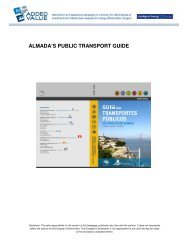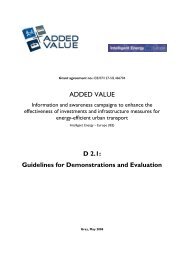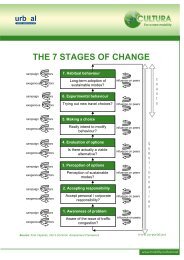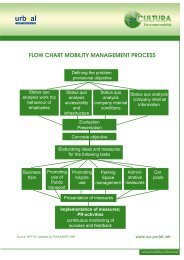SUMO - Eltis
SUMO - Eltis
SUMO - Eltis
Create successful ePaper yourself
Turn your PDF publications into a flip-book with our unique Google optimized e-Paper software.
Specific and clear goals should as far as possible specify what is to be achieved. “Cycle<br />
helmet use should increase” is far more specific than “Safety should improve for<br />
cyclists”. Even more specific would be “Cycle helmet use should increase among adults<br />
in town X”.<br />
If the targets are not formulated to make them measurable then they are not binding.<br />
“Cycle helmet use among adults in town X is to rise from 10 per cent to 15 per cent”<br />
is one such measurable target. This target requires a preliminary assessment, so that one<br />
knows the starting point, in this case that cycle helmet use is 10 per cent.<br />
Ambitious and demanding targets stimulate activities to achieve them, while targets<br />
that are easy to achieve do not give this effect. A target that “Cycle helmet use is to<br />
increase by 0.5 per cent” would not give an effect.<br />
However, it is important that targets are not so ambitious that they become unrealistic.<br />
Many times one is so keen to achieve a result that the targets set are unrealistically high.<br />
This leads people to give up quickly as they are perceived as unattainable. The challenge<br />
is to make the targets both demanding and realistic.<br />
Targets should also be time-limited. This is necessary if work is to be efficient. “Cycle<br />
helmet use among adults in town X is to rise from 10 per cent to 15 per cent between<br />
2004 and 2006” shows how a time-limited target can be formulated.<br />
4.3 CITY-WIDE OR SITE-SPECIFIC PROJECTS HAVE<br />
DIFFERENT TARGET GROUPS<br />
<strong>SUMO</strong> can be applied to different forms of mobility projects for either a whole city<br />
(broad campaigns targeting all inhabitants, mobility offices etc.) or a specific place (i.e.<br />
targeted measures in a residential area, at a company etc.).<br />
City-wide applications often include all inhabitants and visitors to a city or region, but<br />
could also concern a specific target group, such as young people in a city. Target groups<br />
are often heterogenic and it is therefore often necessary to identify several target groups<br />
with different needs. One general weakness with a city-wide application is anonymity<br />
among people included in the target groups.<br />
Site-based applications of mobility management and other mobility projects concern<br />
individual journeys to or from a specific place, i.e. a company. Often the people included<br />
in target groups are known and mobility services can therefore be tailored for<br />
their individual needs.<br />
4.4 TARGET GROUPS<br />
It is important to define target groups for different measures in a project, in part to<br />
focus measures on groups that can produce the greatest effect. This concerns a description<br />
of level P in the <strong>SUMO</strong> model. The division of target groups can be based on<br />
various criteria, such as:<br />
• the aim of the journey<br />
• journey relations (i.e. different combinations of start and destination points)<br />
• geography, such as living in a certain area, or a town (see above)<br />
sumo – System for Evaluation of Mobility Projects<br />
PROJECT DESCRIPTION AND OVERALL GOALS<br />
19








